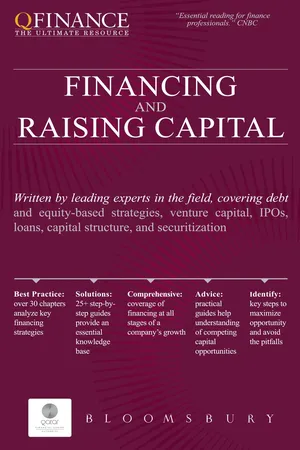Business
Debt vs Equity
Debt and equity are two primary sources of funding for businesses. Debt involves borrowing money that must be repaid with interest, while equity involves selling ownership stakes in the company. Debt provides immediate funds but comes with the obligation of repayment, while equity offers long-term investment but dilutes ownership and may involve sharing profits.
Written by Perlego with AI-assistance
Related key terms
1 of 5
12 Key excerpts on "Debt vs Equity"
- Hans Landström(Author)
- 2017(Publication Date)
- Edward Elgar Publishing(Publisher)
Another is the high cost of capital due to the high required rate of return. 6.1.2 Comparing debt and equity finance We can conclude that debt and equity capital have different charac- teristics, which means that from the perspective of an entrepreneurial venture, debt and equity can be regarded as more or less appropriate depending on the situation (Storey and Greene, 2010). For example, although we know that debts are the most commonly used source of external financing in entrepreneurial ventures (Cosh et al., 2009; Robb and Robinson, 2014), it is generally argued that debt capital is unsuitable for early-stage ventures (Carpenter and Petersen, 2002). The reason is because debt providers require collateral and increase financial distress as interest on and amortization of the loan have to be paid regularly, whereas equity providers are willing to bear the risk and in expectation of gaining from the potential future growth of the venture, do not require collateral and do not increase the financial distress in the venture. Although the number of ventures that will grow is very small, equity capital might be more appropriate than debt finance for fast growing ventures. In fast growing ventures the risk and uncertainty involved is high (Brierley, 2001); usually the ventures have few assets to offer as collateral for a loan and, as equity financing does not increase the financial distress in the venture, equity capital and not least venture capital is usually regarded as more appropriate than debt finance in growth-oriented ventures (Amit et al., 1998). 6.2 Defining debt financing and asset-based financing In the rest of this chapter I will elaborate on different forms of debt financing. Initially, I will make a distinction between different forms of bank debt financing, thus, distinguishing between the different roles of bank debt financing, followed by the differences between bank debt financing and asset-based financing, for example, factoring and leasing finance.- Ellie (Larelle) Chapple, Alex Wong, Richard Baumfield, Richard Copp, Robert Cunningham, Akshaya Kamalnath, Katherine Watson, Paul Harpur(Authors)
- 2022(Publication Date)
- Wiley(Publisher)
For example, financial institutions may already have enough exposure to the company or to the sector that the company is in. Alternatively, the rate of return offered by the company may not be sufficient to entice equity investors to take up shares in the company. Therefore, in many cases companies will need to consider both financing options. 10.1 Choosing between equity and debt LEARNING OBJECTIVE 10.1 Discuss the broad issues to be considered in choosing between equity and debt to raise funds. To raise funds, companies choose between equity and debt — or, more usually, they have a combination of both (figure 10.1). When we say a company is raising funds via equity financing, we mean that it is issuing shares to raise funds from investors (shareholders). In other words, investors are giving funds to the company in return for a share in the company and the rights that go along with it. When we say a company 252 Company law is raising funds via debt financing, we mean that it is borrowing money. This is not fundamentally different from an individual taking out a loan. FIGURE 10.1 Financing a company Debt financing Equity financing Pay dividends Confer rights Sell an ownership stake in the company Shares Repay principal Pay interest Offer security Loans There are advantages and disadvantages for the company in choosing either option. Similarly, there are advantages and disadvantages for an investor or lender in choosing to provide funds to the company by buying shares or lending funds. Issues to be considered by the company, investors and lenders include the following. • The company can claim a tax deduction for interest paid on borrowings. • The company cannot claim a tax deduction for dividend payments. • Interest payments received and dividends received are taxable in the hands of the investor who receives these payments. • Franked dividends carry certain tax benefits for the shareholder.- eBook - PDF
- Bloomsbury Publishing(Author)
- 2015(Publication Date)
- Bloomsbury Information(Publisher)
Best Practice Issuing Debt Optimizing the Capital Structure: Finding the Right Balance between Debt and Equity by Meziane Lasfer EXECUTIVE SUMMARY • Just over 50 years ago Miller and Modigliani (1958) showed that under a certain set of conditions—namely perfect capital markets with no taxes and agency conflicts—a firm's capital structure is irrelevant to its valuation. • Their results are controversial and have raised a large number of questions from academics and practitioners. • This article summarizes the main issues underlying the choice by firms of an appropriate capital structure, taking into account their specific fundamentals as well as macroeconomic factors. • It presents the benefits and costs of borrowing, describes how to assess these to arrive at the basic trade-off between debt and equity, and examines conditions under which debt becomes irrelevant. c era TYPES OF FINANCING There are three financing methods that companies can use: debt, equity, and hybrid securities. This categorization is based on the main characteristics of the securities. Debt Financing Debt financing ranges from simple bank debt to commercial paper and corporate bonds. It is a contractual arrangement between a company and an investor, whereby the company pays a predetermined claim (or interest) that is not a function of its operating performance, but which is treated in accounting standards as an expense for tax purposes and is therefore tax-deductible. The debt has a fixed life and has a priority claim on cash flows in both operating periods and bankruptcy. This is because interest is paid before the claims to equity holders, and, if the company defaults on interest payments, it will be declared bankrupt, its assets will be sold, and the amount owed to debt holders will be paid before any payments are made to equity holders. - eBook - PDF
Financial Accounting Theory and Analysis
Text and Cases
- Richard G. Schroeder, Myrtle W. Clark, Jack M. Cathey(Authors)
- 2022(Publication Date)
- Wiley(Publisher)
545 15 Equity is the basic risk capital of an enterprise. Equity capital has no guaranteed return and no timetable for the repayment of the capital investment. From the standpoint of enterprise stability and exposure to risk of insolvency, a basic characteristic of equity capital is that it is permanent and can be counted on to remain invested in good times as well as bad. Consequently, equity funds can be most confidently invested in long-term assets, and it is generally thought that equity funds can be exposed to the greatest potential risks. Investors deciding whether to purchase a company’s common stock must balance the existence of the company’s debt, which represents a risk of loss of investment, against the potential of high profits from financial leverage. The mix of a company’s debt and equity capital is termed its capital structure. Over the years, there has been considerable debate over whether a firm’s cost of capital varies with different capital structures. Specifically, financial theorists and researchers have espoused theories and examined empirical evidence to discern whether different mixtures of debt and equity in a firm’s capital affect the value of the firm. Modigliani and Miller found that an enterprise’s cost of capital is, except for the tax deductibility of interest, not affected by the mix of debt and equity. 1 This is true, they asserted, because each individual stockholder can inject his or her own blend of risk into the total investment position. In this chapter, we maintain that the degree of risk associated with an investment in an enterprise as perceived by a potential investor is a given. In the following paragraphs, we review some theories of equity and discuss the theoretical issues associated with how companies do and/ or should report the various components of equity. Theories of Equity Chapter 11 introduced two theories of equity: the proprietary theory and the entity theory. - eBook - PDF
Financial Accounting Theory and Analysis
Text and Cases
- Richard G. Schroeder, Myrtle W. Clark, Jack M. Cathey(Authors)
- 2019(Publication Date)
- Wiley(Publisher)
15 514 Equity Equity is the basic risk capital of an enterprise. Equity capital has no guaranteed return and no timetable for the repayment of the capital investment. From the standpoint of enterprise stability and exposure to risk of insolvency, a basic characteristic of equity capital is that it is permanent and can be counted on to remain invested in good times as well as bad. Consequently, equity funds can be most confidently invested in long-term assets, and it is generally thought that equity funds can be exposed to the greatest potential risks. Investors deciding whether to purchase a company’s common stock must balance the existence of the company’s debt, which represents a risk of loss of investment, against the potential of high profits from financial leverage. The mix of a company’s debt and equity capital is termed its capital structure. Over the years, there has been considerable debate over whether a firm’s cost of capital varies with different capital structures. Specifically, financial theorists and researchers have espoused theories and examined empirical evidence to discern whether different mixtures of debt and equity in a firm’s capital affect the value of the firm. Modigliani and Miller found that an enterprise’s cost of capital is, except for the tax deductibility of interest, not affected by the mix of debt and equity. 1 This is true, they asserted, because each individual stockholder can inject his or her own blend of risk into the total investment position. In this chapter, we maintain that the degree of risk associated with an investment in an enterprise as perceived by a potential investor is a given. In the following paragraphs, we review some theories of equity and discuss the theoretical issues associated with how companies do and/ or should report the various components of equity. Theories of Equity Chapter 11 introduced two theories of equity: the proprietary theory and the entity theory. - eBook - PDF
- Anthony N Birts(Author)
- 2001(Publication Date)
- Woodhead Publishing(Publisher)
12 Balance sheet structures To summarise so far, though, before we continue: • In a perfect world the debt/equity decision is of no importance. • But the world is not perfect, and a major imperfection is tax. • Where a company is paying tax, there is an advantage in leveraging up the company to increase total flows from the company. • Personal taxes may be important as it is the total net of tax flows that debt and equity holders are interested in. • Therefore, where debt is favoured by the tax regime, the company should borrow the maximum amount possible. Effect on risk and required rates of return It is now time to consider the second level mentioned earlier, that is the question of increasing risk and its effect on required rates of return. In financial terms, risk is the chance that the outcome will not be as expected. We may expect a return of 15% from an equity investment, but it could be 10% or 20%, depending on a number of issues. The greater the potential variability, the greater the risk. The total risk of a company can be divided into business risk and financial risk. (The distinction between diversifiable and undiversifiable risk is made later.) Business risk derives from the nature of the business itself, e.g. bioengineering is less predictable than producing basic foodstuffs. Financial risk, on the other hand, is a result of the way in which a company chooses to finance itself. Increasing levels of debt are usually seen as increasing the risk to equity holders. This is due to the fact that, while dividend payments do not have to be made in a year in which there is a shortfall of cash, interest payments on debt do have to be paid. Failure to pay interest when due may lead to breaches of covenant and bankruptcy. In a bankruptcy, equity holders are unlikely to receive all of their capital, since a very different valuation is put on assets in a forced sale from that in a going concern. - eBook - PDF
- Stephen Bottomley, Kath Hall, Peta Spender, Beth Nosworthy(Authors)
- 2017(Publication Date)
- Cambridge University Press(Publisher)
We examine the nature of share finance (including different types of shares), the different forms of debt finance (including debentures), and the nature of security interests. We consider share capital transactions includ- ing dividends, alterations and reduction of capital, share buy-backs and financial assistance transactions. In Chapter 9 we look at the rules concerning the raising of capital including the disclosure requirements in ch 6D of the Corporations Act 2001 (Cth). 8.10 The concept of capital In this chapter, and Chapter 9, frequent reference is made to the concept of a company’s capital. The meaning of ‘capital’ varies depending upon the context: According to the context the word may mean wealth, a factor or means of production, the value of those means of production, the net worth of a business enterprise, the present value of a future sequence of receipts, money, the money value of assets and possibly other things as well. Capital is thus thought of in physical terms, in value terms and in money terms. 1 However, the primary aspect of capital that must be understood here is the distinction between share capital (also known as ‘equity’) and debt capital. Share or equity capital is raised by the company issuing shares. The legal relationship between the company and its shareholders is complex. In the commonly understood but legally incorrect sense the shareholders ‘own’ the company and so the legal relationship is often described in terms of the proprietary rights held by the shareholder. However, due to the concept of corporate legal personality, shareholders do not own the property of the company – the company does. The legal nature of a share is discussed below at 8.15.15. By comparison, debt capital refers to borrowings by the company. The legal relationship between the company and a lender is that of debtor and creditor and is predominantly regu- lated by contract law. - eBook - PDF
Financial Accounting
Reporting, Analysis and Decision Making
- Shirley Carlon, Rosina McAlpine, Chrisann Lee, Lorena Mitrione, Ngaire Kirk, Lily Wong(Authors)
- 2021(Publication Date)
- Wiley(Publisher)
For small business, this usually involves a visit to the bank. For public companies, the decision is more complex because they have more alternatives — public companies can raise money from the public in the form of debt or equity. The advantages of debt financing relative to issuing more shares are depicted in figure 10.18. We will now focus on how the return on ordinary shareholders’ equity can be increased by the effective use of debt. To illustrate the potential effect of debt on the return on ordinary shareholders’ equity, assume that Magpie Ltd is considering two plans for financing the construction of a new $5 million factory. Plan A involves issuing 200 000 shares at the current market price of $25 per share. Plan B involves issuing $5 million, 12% unsecured notes. Assume that profit before interest and tax on the new factory will be $1.5 million; income tax is expected to be 30%. Magpie Ltd currently has CHAPTER 10 Reporting and analysing equity 539 equity of $2.5 million. The alternative effects on return on ordinary shareholders’ equity are shown in figure 10.19. In calculating the estimated return on ordinary shareholders’ equity for Plan A, the issue of shares, we include the increase in capital in equity. We do not include the change in retained earnings as this would involve numerous assumptions about dividend policy. We have no reason to expect that dividend policy will vary between financing alternatives. Implicitly, this approach assumes a dividend payout of 100% for both plans. Note that with long-term debt financing (notes), profit is $420 000 less than with equity financing ($1 050 000 − $630 000). However, return on ordinary shareholders’ equity is higher because equity is lower. FIGURE 10.18 Advantages of debt financing over issuing ordinary shares Shareholder control is not affected. Noteholders do not have voting rights, so current owners (shareholders) retain full control of the company. - eBook - PDF
- John B. Vinturella, Suzanne M. Erickson(Authors)
- 2003(Publication Date)
- Academic Press(Publisher)
Chapter 2 Alternatives in Venture Financing—Debt Capital CHAPTER GOALS In this chapter you will learn about: . several options that are available to the firm as debt financing . the best way to prepare yourself before approaching a lender, in order to increase the probability of securing financing . various terms of repayment that can be attached to loans . methods of estimating the firm’s need for external funds by preparing pro forma income statements and balance sheets INTRODUCTION There is no one best method of raising capital. Financing methods will vary with changes in the economy, competitive factors, and as a result of legal, legislative, and regulatory actions. Top entrepreneurial companies use various combinations of debt and equity, depending on which is the most advantageous for the particular stage of growth they are financing. Their aim in financing is to create increasingly higher valuations for the firm by minimizing the total cost of raising capital. Bank debt is not a major source of financing in the earliest stages of a start-up. The use of bank debt virtually always requires that some equity has come in first. A bank will look at how much equity the entrepreneur has committed to the business as a signal of the entrepreneur’s faith in the business. In addition, banks usually require an operating history, supported by financial 41 statements, of 3 to 5 years to demonstrate the viability of the business. Once an operating history has reduced the risk to the prospective lender, a rough rule of thumb is that a dollar of early-stage equity can support a dollar of debt, if there is some additional collateral to further back the debt. Lenders often feel that a start-up will have difficulty in quickly generating the sales or cash flow necessary to service the debt. Consequently, the lender will want to have his or her debt secured with a tangible asset with a reasonable secondary market value. - eBook - PDF
- Laurence Booth, Ian Rakita(Authors)
- 2020(Publication Date)
- Wiley(Publisher)
2 Decisions about the capital structure of the firm involve questions of how this invested capital is financed, including what proportion will be financed through debt and what proportion through equity. How the firm arrives at these decisions is the focus of Chapter 21. The simplified balance sheet in Table 20.2 gives an example of one firm’s capital structure. The financial structure is $2,000, which is the firm’s total assets, while the capital structure components total $1,700, consisting of $1,000 in shareholders’ equity and total interest‐bearing debt of $700 (i.e., $50 + $650), producing a debt‐to‐equity ratio of 0.7 (i.e., $700/$1,000). This hypothetical capital structure has a bit less debt than is typical of Canadian firms. Figure 20.1 shows the average debt‐to‐equity ratio for Canadian firms from 1988 until September 2018. The ratio hovered around 1.15 in the early 1990s but has declined since then and has averaged 0.93 since 2000. capital structure how a firm finances its invested capital debt‐to‐equity ratio the ratio of interest‐bearing debt to shareholders’ equity plus minority interest TABLE 20.2 A Simplified Balance Sheet Cash and marketable securities 50 Accruals 100 Accounts receivable 200 Accounts payable 200 Inventory 250 Short‐term debt 50 Prepaid expenses 0 Current liabilities 350 Current assets 500 Long‐term debt 650 Net fixed assets 1,500 Shareholders’ equity 1,000 Total assets 2,000 Total liabilities and shareholders’ equity 2,000 FIGURE 20.1 Debt‐to‐Equity Ratio (Quarterly Data) Ratio Year Debt-to-Equity Ratio 0.8 0.9 0.95 0.85 1 1.05 1.1 1.15 1988 1990 1992 1994 1996 1998 2000 2002 2004 2006 2008 2010 2012 2014 2016 2018 Source: Data from Statistics Canada CANSIM series V63465 2 Minority interest arises when a firm reports consolidated financial statements. GAAP requires consolidated statements when a subsidiary is not 100-percent owned, but is controlled. - eBook - ePub
Real Estate Analysis
A Toolkit for Property Analysts
- David Rees(Author)
- 2023(Publication Date)
- Routledge(Publisher)
2 Debt, equity and the cost of capital Can debt add value and enhance investment returns?DOI: 10.1201/9781003111931-2Real estate is tangible and immovable; ownership is usually clearly defined and assets are often secured by long-term contractual income streams. In liquid real estate markets, readily available transaction evidence means that the underlying value of assets can be assessed and changes in value monitored with reasonable accuracy. For all these reasons real estate assets are attractive securities to banks and other debt providers.Debt, being typically cheaper than equity, enhances returns to real estate equity investors. More contentiously it is sometimes claimed that “cheap” debt added to the capital stack facilitates investment by reducing the weighted average cost of capital (WACC) of the enterprise, allowing equity investors to achieve desired or pre-specified hurdle rates of return on their investment.While the arithmetic appears convincing, and there may be a good reason to include debt in a capital structure, the impact of debt on the overall cost of capital and its contribution to investment performance requires analysis. The search for the “optimal” or “appropriate” ratio of debt to equity for real estate investments, and the impact of debt finance on investment returns, are high on the financial market research agenda.Introduction: Debt and the law of one price – the essential insight
Ms Brown and Mr Smith are next-door neighbours. Their houses are identical. Ms Brown owns her house debt-free but Mr Smith has a mortgage of £200,000.00 secured against his house. Ms Brown offers her house for public sale and after a competitive marketing process, she accepts an offer of £800,000.00.What is Mr Smith’s house currently worth?Since the houses are identical and adjacent to each other it can fairly be judged that the market value of Mr Smith’s house is also £800,000.00. This is despite the fact that Mr Smith’s house is encumbered with a mortgage, while Ms Brown is mortgage-free. Mr Smith’s equity in his house is, therefore, £800,000.00 − - eBook - PDF
- Henry E. Riggs(Author)
- 2022(Publication Date)
- Springer(Publisher)
A quick example is as follows. Suppose Company Z needs additional capital and is debating whether to sell new debentures (debt) or issue and sell more common shares. Z’s directors feel that the common share price at $25 per share is unattractively low and the anticipated interest rate on debentures at 8% is unattractively high. Z might decide to sell convertible bonds—each $100 bond being convertible into, say, three shares of common stock. Because of this “equity kicker”— that is, the opportunity for the buyers of the bond to become common shareholders if Z prospers—Z is able to sell the bonds with a 6% interest (coupon) rate. If the market price of Z’s common shares appreciates beyond $33.33 per share, the conversion privilege is attractive—the conversion is “in the money”—and Z will, in effect, have sold the new shares for $33.33 rather than $25. A final caveat in our discussion of forms of securities (debt, common equity, and preferred stock): each has unique income tax implications for investors that influence their relative attractiveness. In short, “see your tax accountant!” WHEN IS BORROWING MORE ATTRACTIVE THAN SELLING ADDITIONAL EQUITY? If debt funds are cheaper than equity funds, why do companies not use more debt? If funds obtained through the sale of common stock are less risky, why do companies ever use debt? CAPITAL STRUCTURE 65 Those two questions answer each other. Obviously, some combination of debt capital and equity capital appears to be ideal: balance risk and cost. Before we consider how to make that tradeoff, look first at the advantage of using debt. DEBT LEVERAGE Debt leverages—that is, it can potentially push up or push down—returns to the common shareholders. We say that a company that uses lots of debt is highly debt leveraged. A simple example: if Company D can borrow long term at an interest rate of 7% and can invest those funds in projects that earn an 11% return, the incremental 4% accrues to the benefit of the shareholders.
Index pages curate the most relevant extracts from our library of academic textbooks. They’ve been created using an in-house natural language model (NLM), each adding context and meaning to key research topics.











